May 20, 2025 | 01:49 GMT +7
May 20, 2025 | 01:49 GMT +7
Hotline: 0913.378.918
May 20, 2025 | 01:49 GMT +7
Hotline: 0913.378.918
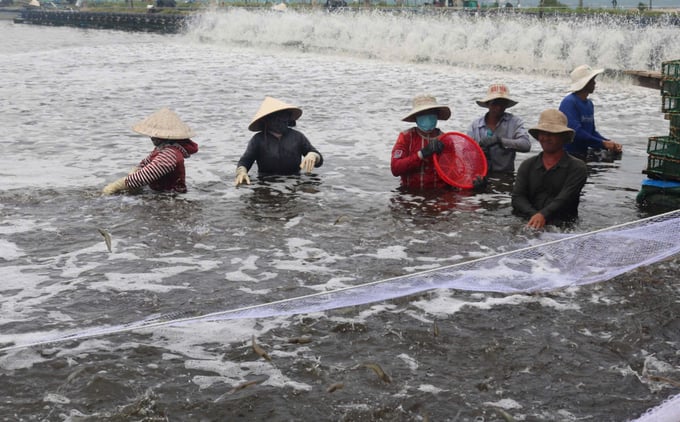
White-leg shrimp farming is a flourishing activity, largely due to the significant contributions of the Research Institute for Aquaculture 3. Photo: KS.
Over the past 40 years, dedicated research efforts from scientists at the Research Institute for Aquaculture 3 (RIA3) have played a crucial role in advancing the field of aquaculture. Their work has significantly enhanced the development of aquaculture in Central Vietnam and across the country, increasing both the scale of production and the quality of products to meet domestic consumption and export demands.
Reflecting on the Institute's history of 40 years, Dr. Truong Quoc Thai, Director of the Nha Trang Marine Research and Development Center (an agency operating under the Institute), noted that one of the Institute's prominent scientific and technological achievements has been the successful research and establishment of artificial breeding processes for several economically valuable aquaculture species. Consequently, the Institute has contributed significantly to genetic conservation, biodiversity, and socio-economic development efforts in provinces across the country.

A research facility for aquatic breeds at the Nha Trang Marine Research and Development Center. Photo: Kien Trung.
According to Dr. Truong Quoc Thai, throughout its various stages of formation and development, the Institute's research team has labored continuously to overcome challenges and achieve remarkable successes. In the years between 1984 and 1994, the Institute's early workforce consisted of only 14 staff members, supported by inadequate and outdated facilities. However, driven by determination and relentless effort, the Institute (formerly known as the Research Center for Aquaculture 3) successfully developed a breeding program for giant freshwater prawn.
This achievement made a substantial contribution to the development of the giant freshwater prawn breeding industry in Central Vietnam, which was subsequently expanded throughout the country through technology transfer and technical training initiatives. The Institute successfully studied and produced a several parent stocks between 1994 and 2014; the mud crab breeding program was particularly noteworthy.
The Institute transferred and applied its research results in various coastal regions across the country. Several provinces, such as Ca Mau, Hai Phong, Quang Ninh, Ninh Binh, Ha Tinh, and Nghe An, successfully adopted the transferred technology. This widespread adoption led to the establishment of a domestic mud crab breeding industry, which enabled crab farmers to become self-sufficient in production, thereby reducing reliance on wild-caught larvae and enhancing economic efficiency.
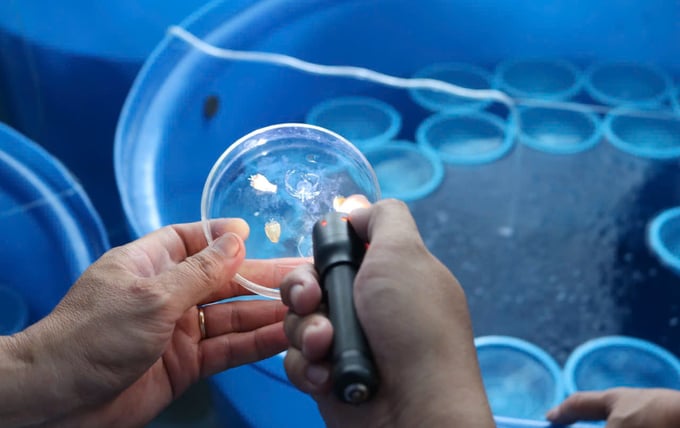
Scientists at the Institute have worked tirelessly to master the technology for producing various high-value aquaculture species. Photo: KS.
Additionally, the Institute was the first in the country to research and successfully establish a breeding process for the spotted babylon snail. Consequently, the spotted babylon snail has become a prominently farmed mollusk species across various regions, yielding high economic returns, contributing to the diversification of farming species, creating employment opportunities, and increasing incomes for local residents.
"During this development process, the Institute pioneered in importing parent stocks of white-leg shrimp and successfully developed a breeding process to supply seeds to domestic shrimp farmers. Furthermore, the Institute has transferred this technology to various organizations and farmers, contributing to the development of white-leg shrimp farming nationwide," Dr. Truong Quoc Thai stated.
In addition to continuing the development of previously successful species such as giant freshwater prawn, white-leg shrimp, mud crab, and spotted babylon snail, the Institute has researched and successfully established breeding processes for several aquaculture species since 2014. These include marine fish (barramundi, hybrid grouper, orange-spotted grouper, tiger grouper, red grouper, emperor bream, and smelt-whiting), mollusks (oyster, geoduck clam, abalone, mussel, blood clam, giant clam, and pearl oyster), cold-water fish (sturgeon and salmon), freshwater fish (hemibagrus microphthalmus and bronze featherback), and other economically valuable species such as peanut worms and sea cucumbers.
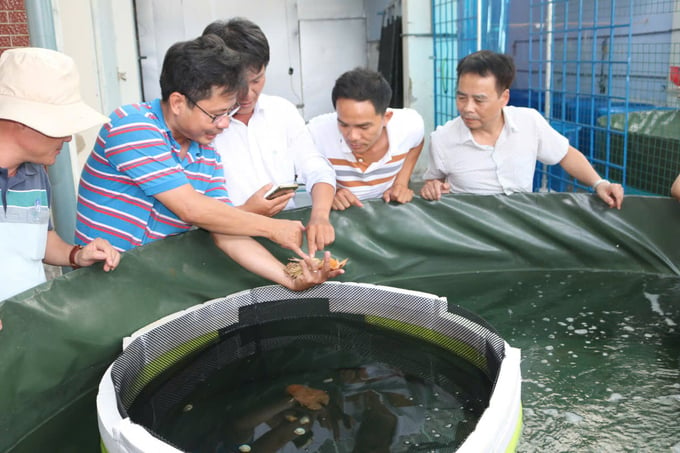
Dr. Truong Quoc Thai (fourth from the right) introducing the Institute's research progress on the slipper lobster. Photo: KS.
Subsequently, the Institute has effectively transferred and applied several notable research results on breeding technologies. These include the breeding technology for barramundi, pearl grouper, peanut worms, single oysters, and pearl oysters. The Institute has transferred these technologies to agencies in Khanh Hoa Province and further disseminated them to various organizations and individuals in other regions. Among these, pearl grouper has become the most widely farmed species of grouper in coastal provinces nationwide.
Additionally, the Institute has successfully applied the breeding technologies for Russian and Siberian sturgeons in Lam Dong Province and several other regions. The technology for sturgeon breeding has played a significant role in the production, supply of seed, and the development of the sturgeon farming industry in Vietnam.
Regarding the future research direction for breeding species to support mariculture, Dr. Truong Quoc Thai stated that the Institute will focus on economically valuable and rare species with significant potential.
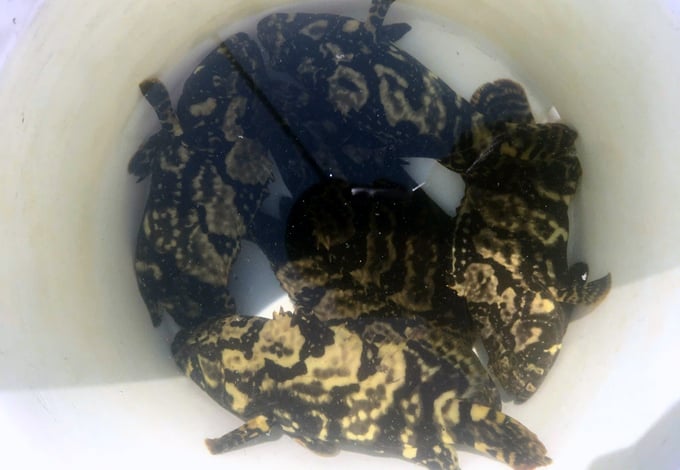
Pearl grouper is one of the primary aquaculture species in the coastal regions of Central Vietnam. Photo: KS.
Researchers at the Nha Trang Marine Research and Development Center are currently studying several new marine fish species, including hybrid grouper, red grouper, humphead wrasse, Northern whiting, and emperor bream. These species hold significant economic value in today’s market.
Additionally, the Center is implementing a breeding program for barramundi with a focus on producing high-quality, fast-growing parent stocks to facilitate seed production. This initiative seeks to shorten the species' growth cycle and enhance economic efficiency for farmers, contributing to the sustainable development of the aquaculture industry.
In addition to marine fish species, scientists at the Center are also researching other economically valuable species such as sea cucumbers, slipper lobster, spiny lobsters, and red crabs, with the goal of creating additional high-value species for mariculture.
According to Dr. Truong Quoc Thai, the Research Institute for Aquaculture 3 is currently conducting a breeding program for aquaculture species. To date, the Institute has successfully developed a fast-growing barramundi parent stock up to the G3 generation, achieving a growth rate exceeding 7% compared to the G2 generation. For white-leg shrimp, the Institute has selected the G8 and G9 generations, with a rapid growth rate of over 5% per generation and disease-free status.
Translated by Nguyen Hai Long
![Reducing emissions from rice fields: [Part 1] Farming clean rice together](https://t.ex-cdn.com/nongnghiepmoitruong.vn/608w/files/news/2025/05/05/z6509661417740_a647202949c539012a959e841c03e1d3-nongnghiep-143611.jpg)
(VAN) Growing clean rice helps reduce environmental pollution while increasing income, allowing farmers to feel secure in production and remain committed to their fields for the long term.
/2025/05/19/5136-1-144800_230.jpg)
(VAN) The Nghe An Provincial People's Committee has just approved the list of beneficiaries eligible for revenue from the Emission Reductions Payment Agreement (ERPA) in the North Central region for the year 2025.

(VAN) 14 out of 35 domesticated elephants in Dak Lak province have had their living conditions improved, with 11 of them currently participating in the non-riding elephant tourism model.

(VAN) Muong Nhe Nature Reserve hopes that being upgraded to a national park will lay the foundation for forest protection efforts to be carried out in a systematic, modern, and sustainable manner.
/2025/05/16/3923-2-171845_52.jpg)
(VAN) Lower costs, higher yields, and improved soil quality are outstanding benefits that soybeans bring when integrated into the crop rotation system.
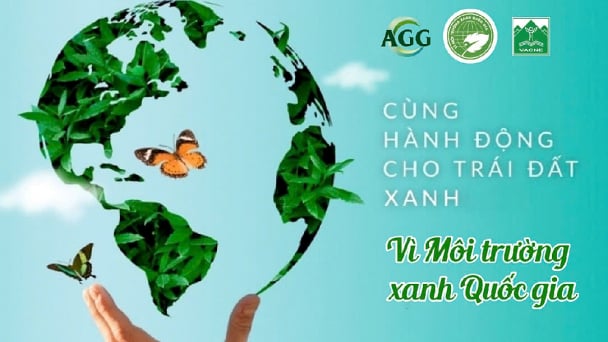
(VAN) The 'For a Green National Environment' programme aims to promote a green lifestyle, support businesses in implementing ESG practices, and turn Net Zero commitments into concrete actions.

(VAN) Cold-barn systems efficiently manage environmental and temperature conditions, which aids in the prevention of respiratory diseases in pigs and protects them from the vectors that transmit African swine fevers.